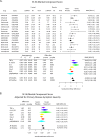Effects of immunomodulatory drugs on depressive symptoms: A mega-analysis of randomized, placebo-controlled clinical trials in inflammatory disorders
- PMID: 31427751
- PMCID: PMC7244402
- DOI: 10.1038/s41380-019-0471-8
Effects of immunomodulatory drugs on depressive symptoms: A mega-analysis of randomized, placebo-controlled clinical trials in inflammatory disorders
Abstract
Activation of the innate immune system is commonly associated with depression. Immunomodulatory drugs may have efficacy for depressive symptoms that are co-morbidly associated with inflammatory disorders. We report a large-scale re-analysis by standardized procedures (mega-analysis) of patient-level data combined from 18 randomized clinical trials conducted by Janssen or GlaxoSmithKline for one of nine disorders (N = 10,743 participants). Core depressive symptoms (low mood, anhedonia) were measured by the Short Form Survey (SF-36) or the Hospital Anxiety and Depression Scale (HADS), and participants were stratified into high (N = 1921) versus low-depressive strata based on baseline ratings. Placebo-controlled change from baseline after 4-16 weeks of treatment was estimated by the standardized mean difference (SMD) over all trials and for each subgroup of trials targeting one of 7 mechanisms (IL-6, TNF-α, IL-12/23, CD20, COX2, BLγS, p38/MAPK14). Patients in the high depressive stratum showed modest but significant effects on core depressive symptoms (SMD = 0.29, 95% CI [0.12-0.45]) and related SF-36 measures of mental health and vitality. Anti-IL-6 antibodies (SMD = 0.8, 95% CI [0.20-1.41]) and an anti-IL-12/23 antibody (SMD = 0.48, 95% CI [0.26-0.70]) had larger effects on depressive symptoms than other drug classes. Adjustments for physical health outcome marginally attenuated the average treatment effect on depressive symptoms (SMD = 0.20, 95% CI: 0.06-0.35), but more strongly attenuated effects on mental health and vitality. Effects of anti-IL-12/23 remained significant and anti-IL-6 antibodies became a trend after controlling for physical response to treatment. Novel immune-therapeutics can produce antidepressant effects in depressed patients with primary inflammatory disorders that are not entirely explained by treatment-related changes in physical health.
Conflict of interest statement
GMW, YZ, YS, DW, BH, MC, GC, and WCD are or were (BH) employed by Janssen Research & Development LLC and hold stock in Johnson & Johnson. ETB was employed half-time by the University of Cambridge and half-time by GlaxoSmithKline. AS, AG, PSJ, SK are or were (AG) employed by GlaxoSmithKline and hold stock in GSK. All the clinical trials were sponsored by GSK or Janssen and the companies retain commercial interests in the development of the drugs reported in this study.
Figures




References
-
- Howren MB, Lamkin DM, Suls J. Associations of depression with C-reactive protein, IL-1, and IL-6: a meta-analysis. Psychosom Med. 2009;71:171–86. - PubMed
Publication types
MeSH terms
Substances
Grants and funding
LinkOut - more resources
Full Text Sources
Medical
Research Materials
Miscellaneous

